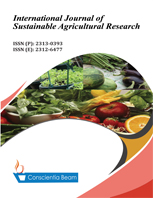Evaluating the relationship between stem and leaf biomass as well as stem length and leaf surface area of amaranth cultivars in improving food plant
DOI:
https://doi.org/10.18488/ijsar.v10i3.3537Abstract
Amaranth is now cultivated almost all over the World for multiple purposes, such as a vegetable, seed food, feed for animals, medicine, and for industry uses. They are highly nutritious, with vitamins and minerals. Leaf area and leaf dry biomass are key parameters linked to plant growth and production. The relationship between leaf biomass and leaf surface area, as well as stem biomass and stem length, is important to our understanding of plant scaling relationships because of their relationship to plant survival. This paper aimed to evaluate the relationship between and within the leaf and stem parameters of nine different amaranth cultivars. The fresh leaves and stems were weighed in their fresh masses; the surface area for leaves was calculated by drawing a full leaf in square quadrats and then counting the square quadrats occupied by a leaf and the stem length was measured using a ruler. Our results indicated that there was a clear relationship between leaf fresh mass and leaf dry mass but a negative correlation between stem fresh mass and stem dry mass due to different internal contents such as water and substances. A low significance was obtained between leaf biomass and leaf surface area, stem biomass and stem length, and leaf biomass and stems biomass as well as leaf surface area and stem length. Our results revealed that this variability of values causes the disproportional ratio of fresh mass to dry mass due to the differentiation quantity of water and solutes within the leaves and stems.

